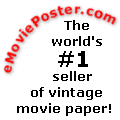From the beginning of the movie
industry, theaters have always looked for alternative suppliers
of advertising to cut costs. Some theaters would contract with
a local to produce material specifically for them... creating
a huge variety of unusual material and also creating posters
that are sometimes hard to identify.
A lot of these printers did
the printing for circus, vaudeville or broadway, they provided
small amount of posters for regional chains or individual theaters.
In the 30's, the 2 major secondary
printers were Leader
Press and the Other
Company. These companies produced a good amount of material
that is fairly easy to recognize because neither one put the
studio name on the posters.
By the mid-1940's, most major
studios had contracted with the National Screen
Service ("NSS") to handle their national distribution of
advertising products. While the posters that were part of the
theatre lobby displays were the full color NSS versions, theatres
looked for an alternative to the materials that were used in
greater numbers, such as window cards
and heralds. This was particularly
true for small theatres and those located in rural areas. (Window
cards were placed in retail and office windows and on utility
poles; heralds were handed out directly to the public). Since
the theatres had to purchase these materials in bulk, they looked
for a cheaper alternative to the NSS materials.
A number of secondary printers came
on the market producing less expensive versions of the window cards
and heralds, usually in two or three colors instead of full color. The
artwork on these secondary materials can be the same or totally different
from the NSS versions. While there were a number of regional secondary
printers that specialized in this type of printing, there were three
printers whose materials are most often found in the movie art industry.
They are as follows:
Many long-time collectors shy away
from collecting materials from these "secondary printers." These posters
do not command the same dollar value as their NSS counterparts, even
though they are the same age, and may be identical to the NSS versions.
These materials are finding a market, however, with newer collectors
for two basic reasons: (1) it is a way to collect original "legitimate"
materials at a less expensive price; and (2) the secondary printers
provided materials for some "B" movies and therefore may be
the only materials available for certain titles.





